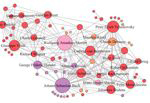EPJ Data Science Highlight - Big Data reveals classical music creation secrets
- Details
- Published on 29 April 2015

Study uncovers how classical music composers collaborate, mix, and influence one another. Results show how culture evolves and predict the future of the recording market
A team of scientists has shed light on the dynamics of the creation, collaboration and dissemination processes involved in classical music works and styles. Their study focuses on analysing networks of composers contemporary to CD publications, using modern data analysis and data modelling techniques. These findings have just been published in EPJ Data Science by Doheum Park from the Graduate School of Culture Technology at Korea Advanced Institute of Science and Technology in Daejeon and colleagues. This work explores the nature of culture in novel ways, as part of a broader movement of applying quantitative methods to music, the visual arts and literature.
The study is based on the largest classical music recordings database to date, using online retailer ArkivMusic and music reference site AllMusicGuide. The authors first focused on understanding how fundamental properties of the network of Western classical music composers correlate with the artistic styles and active periods of their composer. They found such network displays the small-world property and a modular structure.
Park and colleagues also looked at how a network of classical composers developed over time. Specifically, they studied how different composers are “listened to together” by consumers of classical music CDs—a very important aspect in cultural studies. They, then, demonstrated how consumers relate to different composers and styles. This, in turn, provides useful tools to predict the future landscape of the classical recording market.
Specifically, they found that the composer network has evolved by concentrating on top composers while its size grew steadily. In the future, the musical recording landscape is likely to be concentrated around a few composers with an increasing prominence and a greater diversity thanks to a growing number of recorded composers.
Topology and evolution of the network of western classical music composers, D. Park, A. Bae, M. Schich and J. Park (2015), EPJ Data Science, 4:2, DOI: 10.1140/epjds/s13688-015-0039-z





